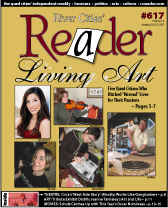 The
e-mail query was direct, but the phrasing was careless: "I'm
working on an article on making a living as an artist ... ," it
began.
The
e-mail query was direct, but the phrasing was careless: "I'm
working on an article on making a living as an artist ... ," it
began.
The response from writer Maureen Wallner came within half an hour: "Making a living," she wrote. "That's funny. If we count fulfillment, I'm a wealthy lady."
Less sarcastically, photographer Jack Wilhoit said: "I don't know any artist ... who is making a living selling their own art."
Wilhoit was speaking broadly, encompassing writers, actors, and musicians along with visual artists. And his point was that nearly all artists need a financial support system, whether it's a retirement income, a working spouse, a day job unrelated to an arts field, or teaching in one's artistic area. That's certainly true for the five Quad Cities artists featured in this article.
Our goal is for these stories to give a sense of how difficult it is to make a living as an artist in the Quad Cities, but also how rewarding. None of these people is "typical," but they give a sense of the wide range of experiences.
The Flat-Footed Violinist
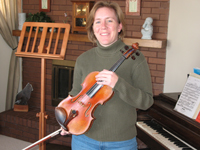 "I thought
I was going to grow up and play in the Chicago Symphony," said
Michele Nemmers. She doesn't say it with disappointment, instead
sounding amused.
"I thought
I was going to grow up and play in the Chicago Symphony," said
Michele Nemmers. She doesn't say it with disappointment, instead
sounding amused.
She compares herself to a flat-footed basketball player who dreams of making it to the NBA: No matter how hard she worked, it just wasn't going to happen.
Nemmers is in her ninth year as a violinist in the Quad City Symphony Orchestra. The combination of playing in the symphony and the Augustana orchestra, serving as the symphony's librarian, and performing at weddings and parties accounts for less than 20 percent of her annual income. The remainder comes from private violin and viola lessons. She presently has 40 students, ranging from third grade to 50 years old.
All told, the 36-year-old Nemmers said, her pre-tax income is roughly $36,000 a year. "It's a decent living," she said, although she was quick to note that self-employment taxes are a pain and that when she's ill she's forced to choose between recuperating and getting paid. Nemmers is lucky in the sense that her family has health insurance through her husband's job.
A Quad Cities native, she got her bachelor's degree from Carnegie Mellon University and a master's degree from the University of Michigan, both in violin performance. (She had also considered becoming a lawyer.)
Nemmers said she was one of only three string players at Michigan who graduated in 1993 and found a full-time performing job. She made about $18,000 a year with the South Dakota Symphony, while the other two made $15,000 (in New Orleans) and $20,000 (in Kalamazoo, Michigan).
What she didn't know after grad school was that most musicians don't land full-time gigs in big cities. Typically, they find a community, play with a regional orchestra, and get the bulk of their incomes through teaching and freelancing. "You were never told" about that by instructors in college, she said. "It's all about perfecting their art."
Nemmers was fortunate to land a full-time job as a musician, but it didn't last. In her third year in South Dakota, she developed tendinitis, and she was forced to decide between performing full-time - likely shortening her career - and scaling back performance to improve her chances of playing the violin in her old age.
That choice brought her back to the Quad Cities, and to the Quad City Symphony. She praised the ensemble - "This is actually a very good orchestra," she said - and added that she loves being one player among many. "It's the teamwork aspect of it," she said. "I love the orchestra playing."
Nemmers estimated that half of the symphony's players earn all of their incomes from music-related endeavors. "There aren't that many of us who are full-time teachers," she said. "There are a lot of people who do other things."
And because relatively few members give private lessons, she doesn't have to worry about the cutthroat business of attracting pupils. In some communities, she said, "people poach each other's students."
Her teaching schedule is structured - 23 hours a week, usually between 4 and 9 p.m. - but the demands of performance are more intermittent. The symphony packs five rehearsals and two performances in eight days one week a month, for instance, while her office duties as librarian add roughly 20 hours a month. (Nemmers orders and prepares the music for orchestra members.)
She said she loves music, but it is definitely a job. She said she doesn't listen to music, and never plays the violin for pleasure. "It would be work," she said.
She doesn't envision herself teaching privately in the long run. She has her teaching certification, sometimes substitutes for orchestra teachers in local schools, and is searching for a full-time classroom position in the Quad Cities.
And she's looking forward to the prospect of paid time off: "I can get sick."
The Retiree
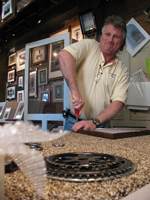 Jack
Wilhoit - known to many people as "The Door Guy" - wouldn't
be able to pursue his art without the federal government. He doesn't
have a National Endowment for the Arts grant, but it's his
retirement income from the Rock Island Arsenal that pays the bills
and gives him the freedom to continue his career in photography.
Jack
Wilhoit - known to many people as "The Door Guy" - wouldn't
be able to pursue his art without the federal government. He doesn't
have a National Endowment for the Arts grant, but it's his
retirement income from the Rock Island Arsenal that pays the bills
and gives him the freedom to continue his career in photography.
Last week at his gallery and studio inside the Bucktown Center for the Arts, Wilhoit said that he's compiled a book of more than 100 of his photographs, organized by country and with a brief narrative about each picture. "The book is completed except for getting somebody to publish it," he said.
Wilhoit enlisted in the Navy after graduating from high school in 1970 and during his four years of service visited 21 countries, including spending two years in Italy. He has now been to all 50 states and to 46 countries. While much of that travel was related to his service in the Navy and his job at the Arsenal, he has recently traveled exclusively to take pictures - to England, Greece, Ireland, and China, for example.
Wilhoit said that although he's been taking photos for decades, he became serious about photography in 1995, a year in which he visited Germany four times for his job at the Arsenal. People liked his pictures, so he printed them for them, and there it began. "Nobody liked the same thing, but everybody liked the door photos," he said.
Doors, particularly in Europe, are Wilhoit's primary subject, followed by bicycles. He finds meaning and beauty in those inanimate objects and variations among them. The doors across the Atlantic hold a particular allure, because the owners of centuries-old buildings use them to give personality to their homes.
With few exceptions, Wilhoit doesn't photograph people, and he said he'll spend as much as 45 minutes on the right shot, waiting for people to get out of the picture frame. One exception is a series of photographs from China, in which the mass of people emphasizes the bicycle as an essential means of transportation.
Wilhoit has about 1,200 to 1,300 photos in his portfolio, but probably has taken 25,000 pictures over the years, he estimated. On his recent trip to China, Wilhoit took 3,000 photos in nine days - the equivalent of 14 rolls a day for a film camera.
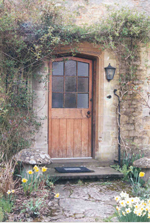 Ironically,
the Door Guy's three favorite shots don't involve doors or bikes
at all. One is an outdoor winter scene; another is a pelican with its
meal airborne between its beak, in the split second before being
swallowed; and a third is called Ghost
Bike, in which a stucco
wall and a bike appear to be fused, when the reality is that it's a
faded and chipped painting of a bike on a wall. All three photos have
won prizes.
Ironically,
the Door Guy's three favorite shots don't involve doors or bikes
at all. One is an outdoor winter scene; another is a pelican with its
meal airborne between its beak, in the split second before being
swallowed; and a third is called Ghost
Bike, in which a stucco
wall and a bike appear to be fused, when the reality is that it's a
faded and chipped painting of a bike on a wall. All three photos have
won prizes.
Wilhoit is sensitive to the criticism that he merely takes pretty photographs. "I look at it as art, but a lot of people look at it as vacation pictures," he said.
On first glance, it's easy to understand the charge, with the images' vivid colors, sharp detail, and elegant, straightforward compositions.
That impression is particularly strong when looking at any single door image, but the collection of hundreds of prints in his Bucktown space gives a different vibe. One begins to notice how the photographs emphasize details - a color, a knocker. There is also the symbolic power of the door - as a gateway, as a barrier. Wilhoit calls the doors "portals to adventures."
With his photography business, Wilhoit said, he makes perhaps a quarter of what he did at the Arsenal. But that's just income; with travel and other costs figured in, he said, he doesn't do much better than break even. "I could not live off of just this," he said. "I'd be a regular at John Lewis Coffee House. ... It's very, very, very. very hard to make a living at it."
His Arsenal retirement income gives him the luxury of devoting himself to his art, but Wilhoit suggested that there was an urgency to shifting from a "day job" to photography. Both his parents died young, and his stepmother died earlier this month.
He took early retirement from the Arsenal in September, and it's clear he's pursuing his photography full-time now in part because of his family history. "I felt anything after 55 was gravy," said the 54-year-old photographer.
The Independent Spirit
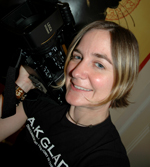 Ange
Glade doesn't have much formal education in her chosen fields -
photography, filmmaking, graphic design. "The only training I truly
got was high school," said the 37-year-old.
Ange
Glade doesn't have much formal education in her chosen fields -
photography, filmmaking, graphic design. "The only training I truly
got was high school," said the 37-year-old.
But over the past two decades, Glade has undertaken a field education in the arts, traveling around the country and learning. After high school, she worked in a photo lab in Austin Texas, and in that town she met filmmakers Robert Rodriguez and Richard Linklater. She was also involved in community television.
In recent years, she photographed jazz legends for the Brooklyn Repertory Ensemble, which in addition to performing supports arts education in schools. That led her to New Orleans, where she photographed more jazz greats and met Herman Leonard, with whose work she was familiar even though she didn't know his name. "He was actually my favorite photographer, and I didn't know it," she said.
"I absorbed all the knowledge I could," she said of her travels and work.
Glade grew up in the Quad Cities and has left and returned multiple times - most recently coming back in April.
She described, in vague terms, a difficult childhood, and adult experiences that provided her a wealth of knowledge, but at a cost. Often, she said, her arts education involved being exploited - long hours and low pay. "A lot of people want things for free," she said.
In New York, she said, she lived in a building that wasn't up to code, and she often ate only one meal a day - two factors that contributed to a serious illness, she said. "Financially, it was always very difficult for me to survive as an artist," she said.
Although she came back to the Quad Cities to reconnect with her family and recuperate, Glade has decided to remain in the area for the time being, with an ambitious slate of projects. Already she has participated in salon nights at the Leger gallery in downtown Davenport, and her work is also on display at Quad City Arts and The Urban Grind in Davenport. Two of her works will be in the Quad City Arts Valentine Art Auction next month. She's working with three galleries to begin teaching in the areas of digital photography, graphic design, and guerrilla filmmaking. She plans to turn her Quad Cities photographs/illustrations into calendars and postcards.
And, most importantly, she wants to do all that to support a Web-based community television station for which she would make documentaries. "I have a higher purpose with art," she said. "I really want to make a difference" - focusing on creative people, not-for-profit organizations, alternative healing, and alternative energy.
Right now, she said, she's earning some income from selling artwork and doing commercial painting - but not nearly enough to survive long-term.
Her experiences have fostered in her an independent spirit, which helps explain why her interest in the visual arts is so wide-ranging. She wants to be able to do everything herself, to not need to rely on others. "I don't have to depend on anyone now," she said.
For all she's been through, snippets of our interview show that she's drawn strength from her travails. "I've paid my dues." "I'm very powerful now." "Now I'm ready to launch."
The Professional
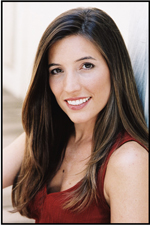 Born
and raised in the Quad Cities, 35-year-old Kimberly Furness has lived
the life that most actors dream of. She cut her teeth in Chicago,
acting for a handful of theatre companies and (of course!) waiting
tables, and then she spent seven years in Los Angeles.
Born
and raised in the Quad Cities, 35-year-old Kimberly Furness has lived
the life that most actors dream of. She cut her teeth in Chicago,
acting for a handful of theatre companies and (of course!) waiting
tables, and then she spent seven years in Los Angeles.
The California experience got off to a rough start - in two weeks in 1998, Furness and her boyfriend (now her husband) ran through the $5,000 they'd saved, living out of a hotel and looking for an affordable, decent apartment - but the actress has no complaints about how things turned out.
She worked in commercials, got a few parts in television series (including That '70s Show), earned her Actors' Equity Association membership card, got an agent, and played the lead role in Cinderella for film director Garry Marshall's Falcon Theatre - even though she is a brunette, thought she was too old for the part, and was an alto auditioning for a soprano role.
She even helped start a theatre organization - the Curtain Box Theatre Company, a play on her maiden name of Kurtenbach - that produced three shows. "We did well," she said. "I didn't make a lot of money, but I didn't lose money."
And the requisite day job - at the Beverly Hills Tutoring Center - was rewarding, as she started answering phones and ended up managing the company. That job gave her a glimpse into the lives of a wide range of celebrities, including Damon Wayans, Danny DeVito, Anna Nicole Smith, and Flea. "It was neat to see the other end of that world," Furness said.
L.A. is famous for chewing up young performers, but Furness said her age - and her understanding of what it takes to make a living from acting - helped her. "I was a little more mature" than many people who move to Hollywood. "I am very proud of what I accomplished in L.A. ... I got to dabble in a little bit of everything."
But she and her husband wanted to start a family and had no interest in doing that in Los Angeles. They returned to the Quad Cities less than two years ago, and Furness thought she was putting her acting career on hold. She contracted with Circa '21 to play one of the leads in The King & I, but figured that would be the end of it.
 Hardly.
Furness has gotten steady stage work from Circa and New Ground
Theatre and has done commercial and voice-over work since her return
to the Quad Cities. "And I teach a lot," she said. She leads
classes at Junior Theatre - where she got her acting start - and
gives private lessons, along with occasional master classes at her
alma mater, St. Ambrose University. She has also directed several
shows in Texas. "I make my living as an actor and a director in the
Quad Cities," she said. "I never expected that."
Hardly.
Furness has gotten steady stage work from Circa and New Ground
Theatre and has done commercial and voice-over work since her return
to the Quad Cities. "And I teach a lot," she said. She leads
classes at Junior Theatre - where she got her acting start - and
gives private lessons, along with occasional master classes at her
alma mater, St. Ambrose University. She has also directed several
shows in Texas. "I make my living as an actor and a director in the
Quad Cities," she said. "I never expected that."
Of course, the Quad Cities is not Los Angeles, and that has its advantages and drawbacks. On the plus side, Furness said she's able to earn a living exclusively through her craft - something that she couldn't do in California. But the theatrical opportunities here are more mainstream and safer than those in Los Angeles.
That doesn't seem to faze Furness. She said the acting talent in the Quad Cities is strong - she singled out her On Golden Pond co-stars Michael Kennedy, Adam Lewis, and Tom Walljasper - and noted that she's a Rodgers & Hammerstein devotee. "I love the old warhorse shows," she said.
She added that she does wish for more professional theatre in the Quad Cities, and newer shows, but that will have to wait until she starts a new theatre company in the area - something she hopes to do. Until then, she said, "I'm just grateful for the work. ... There's a lot of opportunity here."
The Late Beginner
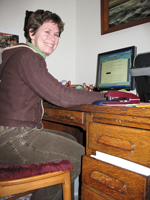 Maureen
Wallner has not done things conventionally. She started college when
she was 35, and even though her husband is a cardiologist, she never
stopped working to pay the bills. "I've been self-supporting all
these years," she said.
Maureen
Wallner has not done things conventionally. She started college when
she was 35, and even though her husband is a cardiologist, she never
stopped working to pay the bills. "I've been self-supporting all
these years," she said.
But she's always found joy in writing. In relatively low-prestige jobs, such as administrative assistant, she got a charge from writing, even if it was merely a business letter.
"I've always been a reader," she said, "and I've always been a poet." But it's only been in the past few years that she's pursued writing fiction full-time.
Jobs got in the way. Most recently, she worked for eight years at Palmer College of Chiropractic. For years, she'd wanted to attend a weeklong Midwest Writing Center conference, but she never had the vacation time. In 2003, her husband prevailed on her to take unpaid time off for the conference, and she won first prizes for both fiction and poetry. (Wallner credits several of her mentors at the Midwest Writing Center with sending her down the right path.) She also got her first published poem that year. But she persisted at Palmer.
In December 2004, she called a psychic; while her husband is a scientist, Wallner said, "I just believe in the possibility of anything." She was told, "I hear in you that there is a fire burning inside of you," she recalled.
Soon after that call, there was an incident in a grocery-store parking lot involving a runaway cart. Wallner was chasing after the cart - which was on a collision course with a car - and tripped and fell. She saw the accident as a metaphor that could not be denied, literally "knocking sense into me, ... physical proof that I'm flat on my face and I'm not going any further." She quit her Palmer job and became a full-time writer.
At age 57, she now has two published short stories and is halfway through her first novel, Free to Be. It's a historical novel, taking place at the turn of the 20th Century in newly independent Romania and Canada, and dealing with the romance between a Jew and a Romani (or "gypsy," to use the commonly used but derisive term) and the conflict between their cultures.
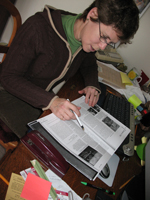 She
began the book in 1995, she said, but set it aside for a decade. Now
she writes daily from at least 8:30 a.m. to 1:30 p.m.
She
began the book in 1995, she said, but set it aside for a decade. Now
she writes daily from at least 8:30 a.m. to 1:30 p.m.
Her work isn't limited to the novel. She's reading historical sources so that her book is accurate, and she's re-reading John Irving's The Cider House Rules to glean insight into the author's craft, particularly his use of point of view. "He has tricks that are amazing," she said, "and I need that."
She's also writing and sending out short stories and poems, laying the groundwork for getting her novel - which she hopes to finish this year - published. "I'm trying to establish my credibility as a writer," she said. One short story, she said, has been through 10 revisions over six months.
No proper job, she said, can compare to the satisfaction of writing. "There's no money that I can balance against doing that [writing]," she said.
Now, she said, instead of work precluding writing, her writing sometimes keeps her from the rest of her life. "Writing gets in the way of living for me," she said. "I'm abandoning all these people [characters]" by going to the grocery store, for example.
And she recognizes that she wouldn't be able to pursue her artistic life without the financial support system that her husband provides; few aspiring artists have the opportunity to ditch "work" for art. "I'm lucky I have a choice."










